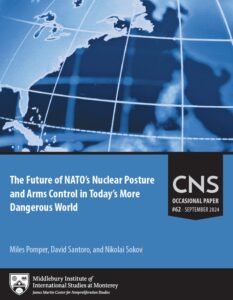September 23, 2024
Miles Pomper, David Santoro, and Nikolai Sokov
Introduction
Since the late 1960s, NATO has sought to balance two objectives—maintaining a strong nuclear deterrent while supporting efforts to buttress strategic stability through arms control and advance nonproliferation and disarmament through the nuclear Nonproliferation Treaty process.
The success of this strategy was most evident in the dual-track strategy of deployments and negotiations that led to the signing and implementation of the Intermediate-Range Nuclear Forces (INF) Treaty in 1987. The end of the Cold War also led to substantial cuts in U.S. and Russian strategic systems.
Since then, NATO Allies have regularly voiced their support for continuing to pursue these two objectives, including supporting the goal enunciated by U.S. President Barack Obama in 2009 “to seek the peace and security of a world without nuclear weapons.”1
In the last decade, however, Russia’s malign behavior has undermined NATO arms control efforts to the point that it appears traditional arms control will be effectively dead when the New START agreement—already suspended by Russia—expires in 2026. Russian’s invasion of Ukraine, its repeated nuclear saber-rattling in that conflict, and the deployment of non-strategic nuclear weapons to Belarus has also forced the alliance to look to ways to enhance its deterrence, including its nuclear deterrence.
Meanwhile, the massive increase in China’s nuclear arsenal and its growing partnership with Russia, is generating additional pressure to increase U.S. nuclear forces as well as questions about the ability of the U.S. to provide extended deterrence simultaneously to Allies in Europe and Asia. Those doubts have been reinforced by political developments in the United States—and in the war in Ukraine—that have raised anxieties about a decoupling of European and U.S. deterrence and defense and led to fresh discussion of a potential “Eurodeterrent.” Meanwhile, developments in North Korea and Iran—and their increasingly close ties with Moscow—further threaten the viability of the already shaky nuclear and missile nonproliferation regimes and have eroded longstanding cooperation between Washington and Moscow to manage nuclear nonproliferation risks in third countries.
In response to these developments, Allies and experts, such as the Congressional Strategic Posture Commission, have proposed various adaptations to the alliance’s nuclear posture, including to its nuclear sharing arrangements. This report examines these deterrence proposals, particularly considering how they support the alliance’s other longstanding objectives of arms control, disarmament, and nonproliferation.
The paper begins with some background on US/NATO nuclear policy from the end of the Cold War to the further invasion of Ukraine in February 2022. It then delves into changes in Russian nuclear doctrine, Moscow’s nuclear behavior during the Ukraine War, and the Kremlin’s views on future arms control. The report next discusses China’s nuclear modernization and views on arms control and the reaction among NATO and Asian Allies and the international community to these changes. It then discusses potential future U.S. and NATO posture options, including those already being undertaken by NATO or proposed by the US. Congressional Strategic Posture Commission and the State Department’s International Security Advisory Board. It concludes with an analysis of the potential impact of various options on arms control, disarmament, and nonproliferation and offers some policy recommendations.

